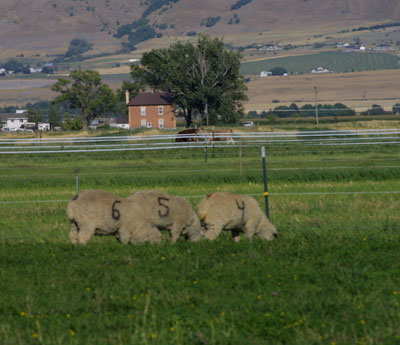Toxins Influence Foraging
Sheep preference for forage species after dosing them with tannins, saponins or alkaloids
All plants contain secondary metabolites (PSMs). These compounds can be toxic at high doses or can act in medicinal ways at low doses. PSMs often provide benefits to plants such as increased pest resistance, drought tolerance or competitive ability. Unfortunately, many of these compounds are toxic to animals (from insects to mammals) and reduce intake of plants.
Study 1
 The objective of this study was to determine how different PSMs might affect the diet selection of sheep grazing forages with different PSMs: 1) alfalfa (saponins), birdsfoot trefoil (tannins) and tall fescue (alkaloids).
The objective of this study was to determine how different PSMs might affect the diet selection of sheep grazing forages with different PSMs: 1) alfalfa (saponins), birdsfoot trefoil (tannins) and tall fescue (alkaloids).
After the early morning dosing with tannins, saponins or an alkaloid (ergotamine) lambs were allowed to graze a pasture that contained birdsfoot trefoil, alfalfa, endophyte-infected tall fescue, and orchard grass.
Trial 1: Lambs gavaged with tannins spent more time grazing birdsfoot trefoil and tall fescue.
Trial 2: Lambs gavaged with saponons spent more time grazing tall fescue and the least time grazing alfalfa.
Trial 3: Lambs gavaged with ergotamie (alkaloid) spent more time grazing birdsfoot trefoil and the least time grazing tall fescue.
Lambs minimized the negative impacts of PSC by changing their foraging behavior to avoid over-ingesting any one PSC and by selectively increasing their preference for forages containing other PSMs.
Reference
- Villalba, J.J., F.D. Provenza, A.K. Clemensen, R. Larsen, and J. Juhnke. 2011. Preference for diverse pastures by sheep in response to intraruminal administrations of tannins, saponins, and alkaloids. Grass Forage Sci. 66: 224–236.
Study 2
The objective of this study was to determine how tannins might affect the diet selection of sheep grazing varieties of alfalfa, birdsfoot trefoil and tall fescue with high and low levels of saponins, tannins and alkaloids, respectively
Trial 1: Lambs that were gavaged with tannins and water and then sent out to graze increased their intake of the high-saponin alfalfa and the high-alkaloid tall fescue compared to lambs gavage with only water (controls).
Trial 2: Lambs gavaged with tannins and then offered choices among the three high-PSM varieties of the forages ate more high-alkaloid tall fescue and less high-tannin birdsfoot trefoil compared to controls.
Lambs changed their diet selection as a function of the presence/absence of tannins in their rumens.
Thus ruminants are able to recognize the negative effects of eating forages high PSMs, and adjust diet selection to complement their current biochemical state. Providing pastures with multiple plant species are likely to increase intake and reduce any ill effects of any one PSM on grazing ruminants.
Reference
- Lisonbee, L.D., J.J. Villalba, and F.D. Provenza. 2009. Effects of tannin on selection by sheep of forages containing alkaloids, tannins and saponins. J. Sci. Food Agric. 89:2668-2677.

